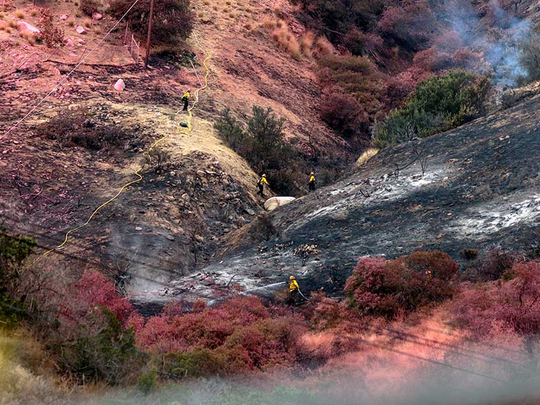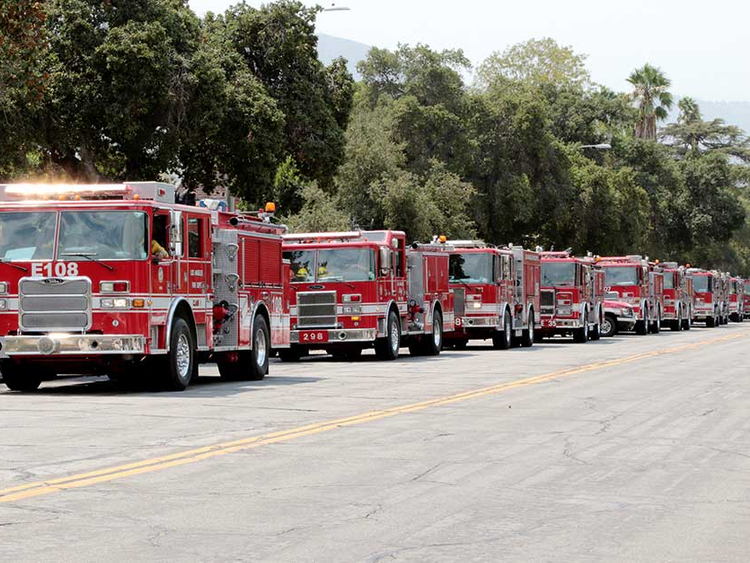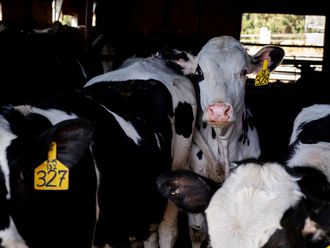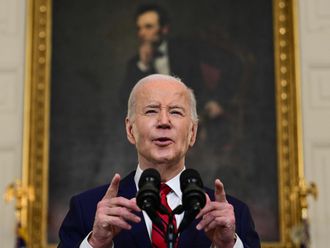
Los Angeles: A smattering of rain and easing temperatures helped more than 1,000 firefighters battling the largest wildfire in Los Angeles history gain the upper hand on the blaze on Sunday, but officials warned that danger remains.
“We’ve turned the corner, but this is not over,” Los Angeles Mayor Eric Garcetti told reporters. “With winds this strong, anything can happen.” Shifting winds could cause burning embers to spread the fire once more through the rugged northern edge of Los Angeles, said Garcetti.
The nearly 2,400-hectare La Tuna Fire, named after the canyon area where it erupted on Friday, has destroyed three homes and damaged one. More than 700 homes were evacuated as the blaze tore through thick brush that has not burned in decades.
Of the 1,400 people evacuated from their homes, 90 per cent had returned by Sunday afternoon and Garcetti said nearly all would be back before the day was over.
The wildfire is the largest in terms of acreage in the city’s history, Garcetti said. It was considered 30 per cent contained by late Sunday night, up from 10 per cent on Sunday morning.
“We do not have this fire contained,” Garcetti said, “but we do have a good sense of, in the next day or two, how we can bring this fire to rest.”
Wildfires forced thousands to flee their homes across the US West during a sweltering, smoke-shrouded holiday weekend of record heat.
The fires on Sunday caused evacuations in Glacier National Park in Montana and many other parts of the West; compelled crews to rescue about 140 hikers who had spent the night in the woods after fire broke out along the popular Columbia River Gorge Trail in Oregon; and led firefighters to step up efforts to protect a 2,700-year-old grove of giant sequoia encroached by flames near Yosemite National Park in California.
A sudden gusty series of rainstorms allowed Los Angeles, however, to cancel evacuation orders for a wildfire that the mayor called the largest in the city’s history and sent beach umbrellas and toy shovels bouncing down Southern California beaches late Sunday.
Garcetti had declared a local emergency earlier Sunday and Governer Jerry Brown did the same on the state level for Los Angeles County after the wildfire destroyed three homes and threatened hillside neighbourhoods. More than a thousand firefighters battled flames that chewed through more than 23 kilometres of brush-covered mountains.
By evening, however, the day’s record heat in Los Angeles had eased and a spate of brief storms even brought a bit of rain to the burning slopes, slowing the progress of the wildfire. Authorities were able to cancel the evacuation orders that had been issued for three cities — Los Angeles, Burbank and Glendale — and allow all of the 1,400 people who had fled to return to their homes.
Conditions slowing the blaze could change again “in a moment’s notice, and the winds can accelerate very quickly”, Los Angeles Fire Capt. Ralph Terrazas warned, however. “There is a lot of fuel out there left to burn.”
Officials were keeping an eye on thunderstorms, which were bringing welcome bursts of rain but also the risk of flash floods, mudslides and lightning. Beachgoers in Santa Barbara filmed one sudden storm there that sent palm trees flapping and toddlers chasing beach toys that the wind was blowing down the beach.
The high at Los Angeles International Airport reached 36 degrees Celsius on Sunday, topping the previous mark of 33C, set in 1982. Records were also set in parts of Ventura and Santa Barbara counties, where the temperature hit 38 Celsius.
San Francisco residents, meanwhile, stifled under a third day of a rare heatwave in the coastal city, although highs in the San Francisco Bay Area fell on Sunday from records in the high 30sC set the previous two days.
“I went to Home Depot, Walgreens, Office Depot, Target. They were sold out!” downtown office worker Alganesh Ucbayonas said on Sunday, detailing her unsuccessful search for an electric fan. “CVS!” she remembered.
On Sunday, Ucbayonas sat at her desk in a building lobby squarely between two whirring fans, both scrounged from her office building’s storage and trained straight at her face.
Fires burning up and down the Sierra Nevada and further to the northwest cast an eerie yellow and grey haze over much of California. Much of the state was under alerts because of poor air quality.
California authorities ordered evacuations for a third small town Sunday in one of the wildfires, a blaze that has burned 23 square kilometres near Yosemite.
Firefighters battling that blaze were making it a priority to safeguard the ancient grove of giant sequoia and a pair of historic cabins at the foot of the trees, fire spokeswoman Anne Grandy said. Fire crews had wrapped the two 19th-century cabins and an outhouse in shiny, fire-resistant material to protect them from the flames that had entered the Nelder Grove, Grandy said.
California crews are also protecting homes from a fast-moving wildfire that forced evacuations in Riverside County.
In Washington state, Gov. Jay Inslee proclaimed a state of emergency across all counties as three major fires closed recreation areas and prompted evacuations.
Flames in Montana’s Glacier National Park prompted officials to evacuate all residents, campers and tourists from one of the most popular areas of the park. The order Sunday affects the Lake McDonald area, the western side of the dizzying Going-to-the Sun Road and some of the most visited trails in the area. The Lake McDonald Lodge, built in 1913, closed last week because of heavy smoke in the area.













